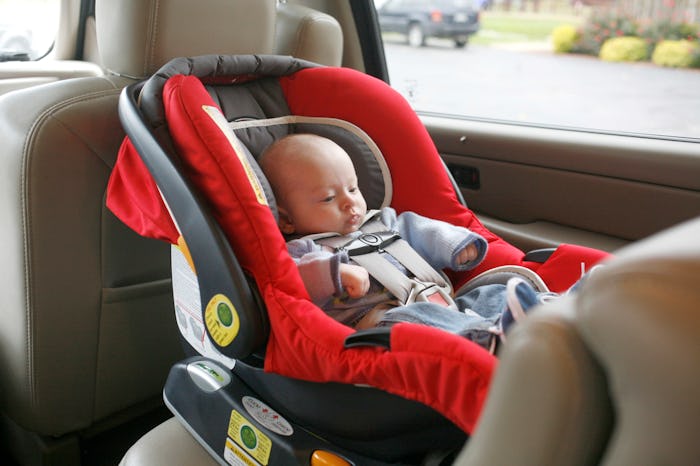Life

This Is Why Coats & Car Seats Can Be A Dangerous Mix For Babies & Toddlers
It’s hard enough to wrangle your baby or toddler into a warm jacket (that they don’t want to wear because, toddlers), so the last thing you want to do is take that jacket off again so you can get your little one buckled in. It's enough to make you wonder... can babies wear coats in car seats?
Unfortunately, the answer is a resounding and emphatic "no" from pretty much every expert who knows anything about child safety. “A car seat or child restraint harness should not be secured over a bulky coat,” Amy Artuso, Senior Program Manager of Grants, Transportation, and Advocacy at The National Safety Council tells Romper.
There are a few reasons why thick coats should be removed; the first is that the jacket can flatten out from the impact of a car crash, as it would if you dropped something on it or stepped on it. “In the event of a crash, bulky coat material will compress under the harness, creating more room between the child and the harness straps, and possibly allowing the child to be ejected from the seat,” Artuso says. This is also true for infants.
She points me in the direction of car seat safety guidelines set out by the Manufacturers Alliance for Child Passenger Safety (MACPS), which explain that “wearing bulky coats may provide enough room for your child to wiggle loose.” It’s terrible to think about, but car seats and harnesses are not designed or tested with puffy coats in mind. “The goal is to keep the child secure... so the child moves with the seat in the event of a crash. In order for that to happen, the harness of the car seat needs to be used correctly and securely,” Artuso says.
You’ll know your child is properly in the seat once the harness is tightly secured over their body. “You want the harness straps snug on the child and that is hard to do with a puffy, thick coat. If the child has on a puffy coat it's hard to tell visually or even by the pinch test if the harness straps are indeed tight enough on the child,” Amie Durocher of Safe Ride 4 Kids tells Romper.
But what is the pinch test? Don't worry, it's easy: When your child is secured in their seat (without their coat on) just pinch the harness straps at their collarbone level; if there is enough excess material that you can grab and pinch between your fingers, the harness is too loose, as explained on Car Seats For The Littles. “While we don’t want to hurt the child by making the straps too tight, harness straps should be snug enough so that you cannot pinch any slack,” Artuso says.
The frustrating thing is that your child still needs a coat for the trip to the car and whatever activity comes after. You could dress your child in layers (you know how they love that… ) and put a thinner jacket under their puff coat. “Thin coats are okay,” Durocher says. “Typically nothing thicker than a sweatshirt or thin fleece material [should be worn]. There are a couple of options [for] thicker coats designed to be able to use in a car seat now [and] least one that I know of has been crash tested.”
Both Durocher and Artuso recommend carrying the child to the car in their jacket, removing it to strap them into their seat, then, once they’re secured, you can put the coat on backward, almost like a blanket with arms, as long as you make sure the hood is not blocking their face. You can also just bring a blanket for the car, and hats and mittens are great.
If you have any questions about car seat safety, Durocher says you can always call the toll-free number provided on car seat labels to reach the manufacturer (who knew that was there!?) and you can also usually meet with a local nationally certified child passenger safety technician (typically at no cost).
It may seem like a drag to take your kids coat on and off, but it’s really important, even if you’re just going on a quick trip. Just think how triumphant your kiddo will feel when you tell them they don’t have to wear their jacket (well, in the car seat).
Experts
Amie Durocher, Creative Director, Safe Ride 4 Kids
Amy Artuso, Senior Program Manager of Grants, Transportation, and Advocacy, The National Safety Council
This article was originally published on